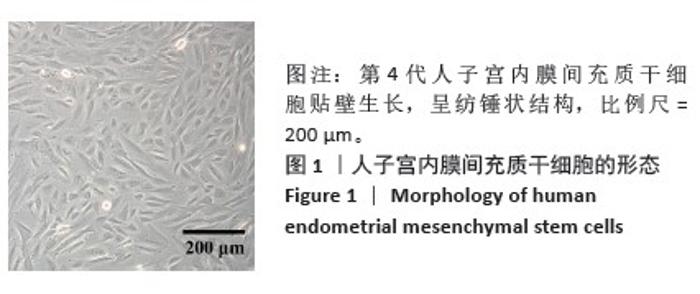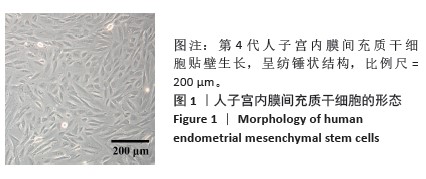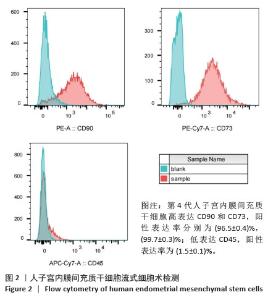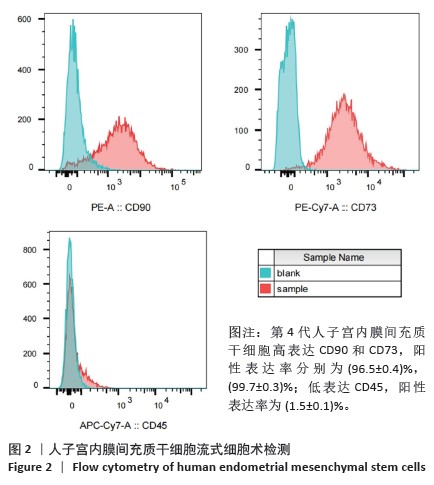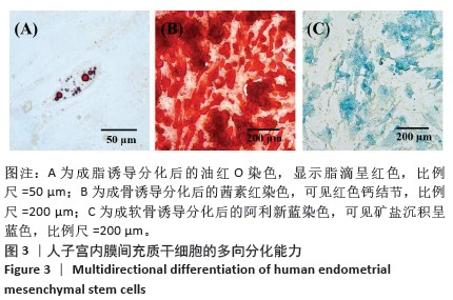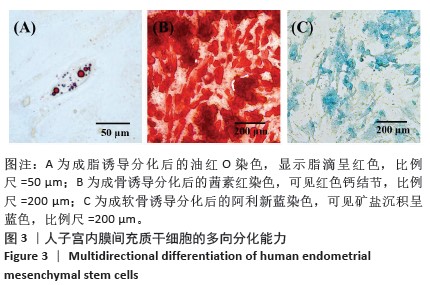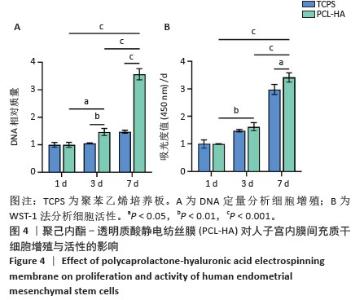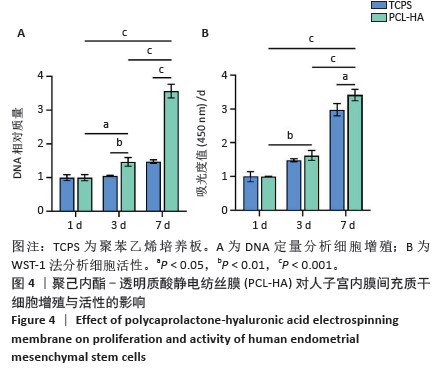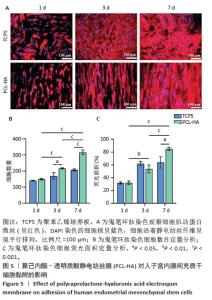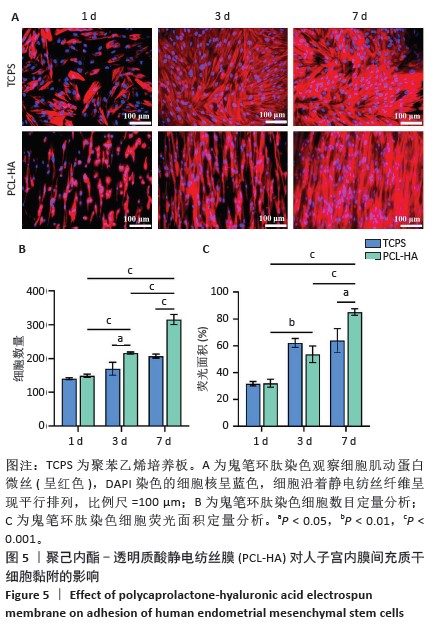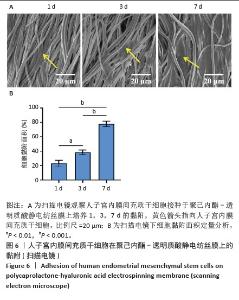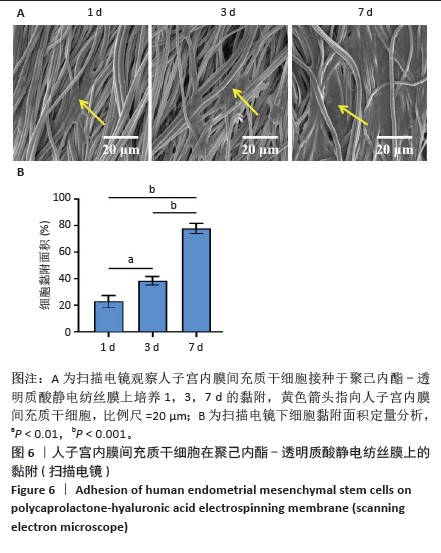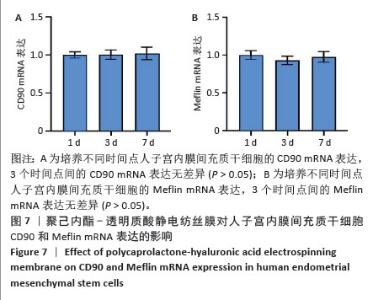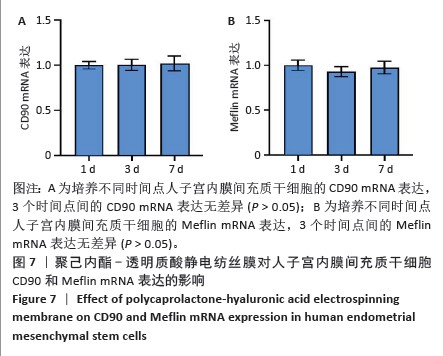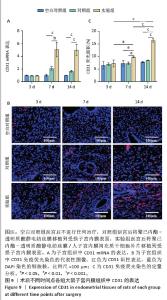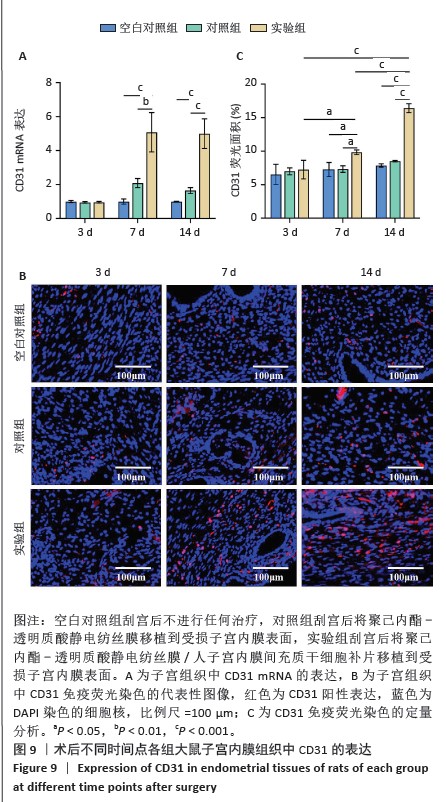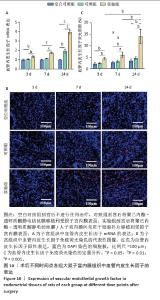Chinese Journal of Tissue Engineering Research ›› 2025, Vol. 29 ›› Issue (16): 3369-3379.doi: 10.12307/2025.429
Previous Articles Next Articles
Mesenchymal stem cells combined with polycaprolactone-hyaluronic acid electrospinning membrane in repair of endometrial injury
An Jiangru1, Zhang Jinyi1, Wang Qiuhua1, Yang Yangyang1, Wang Wenshuang2, Zhang Xiaoqing1
- 1School of Basic Medical Sciences, Binzhou Medical University, Department of Human Anatomy and Histoembryology, Joint Laboratory for International Cooperation in Biomaterials and Tissue Regeneration, Yantai 264003, Shandong Province, China; 2Department of Gynecology, Yantai Yuhuanding Hospital, Yantai 264000, Shandong Province, China
-
Received:2024-02-28Accepted:2024-04-23Online:2025-06-08Published:2024-09-03 -
Contact:Corresponding author: Zhang Xiaoqing, Professor, School of Basic Medical Sciences, Binzhou Medical University, Department of Human Anatomy and Histoembryology, Joint Laboratory for International Cooperation in Biomaterials and Tissue Regeneration, Yantai 264003, Shandong Province, China Corresponding author: Wang Wenshuang, Chief physician, Department of Gynecology, Yantai Yuhuanding Hospital, Yantai 264000, Shandong Province, China -
About author:An Jiangru, Master, School of Basic Medical Sciences, Binzhou Medical University, Department of Human Anatomy and Histoembryology, Joint Laboratory for International Cooperation in Biomaterials and Tissue Regeneration, Yantai 264003, Shandong Province, China -
Supported by:Shandong Provincial Natural Science Foundation-Youth Fund Project, No. ZR2021QC034 (to ZXQ); Mount Taishan Scholar Youth Project, No. tsqn202103111 (to ZXQ)
CLC Number:
Cite this article
An Jiangru, Zhang Jinyi, Wang Qiuhua, Yang Yangyang, Wang Wenshuang, Zhang Xiaoqing. Mesenchymal stem cells combined with polycaprolactone-hyaluronic acid electrospinning membrane in repair of endometrial injury[J]. Chinese Journal of Tissue Engineering Research, 2025, 29(16): 3369-3379.
share this article
Add to citation manager EndNote|Reference Manager|ProCite|BibTeX|RefWorks
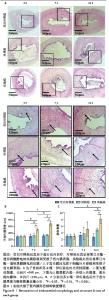
2.3 动物实验结果 2.3.1 实验动物数量分析 27只大鼠全部进入结果分析。 2.3.2 PCL-HA/hEMSCs移植修复宫腔粘连大鼠子宫形态结构 苏木精-伊红染色结果见图8,结果显示空白对照组大鼠子宫内膜发育不良,内膜厚度变薄,腺体数量减少,术后第3,7,14天的子宫内膜厚度和腺体数量比较差异无显著性意义(P > 0.05);术后第7天,相比较于空白对照组和对照组,实验组大鼠子宫内膜厚度明显增加,腺体数量未见明显增加;术后第14天,对照组和实验组大鼠宫腔内仍存在未降解的静电纺丝膜材料,实验组子宫内膜与腺体数目均多于其他两组,证明PCL-HA/hEMSCs补片中的hEMSCs在大鼠子宫内膜中持续发挥作用。这提示PCL-HA/hEMSCs补片能持续在大鼠宫腔内定植,并且hEMSCs持续发挥作用并促进损伤子宫内膜形态结构的修复。"
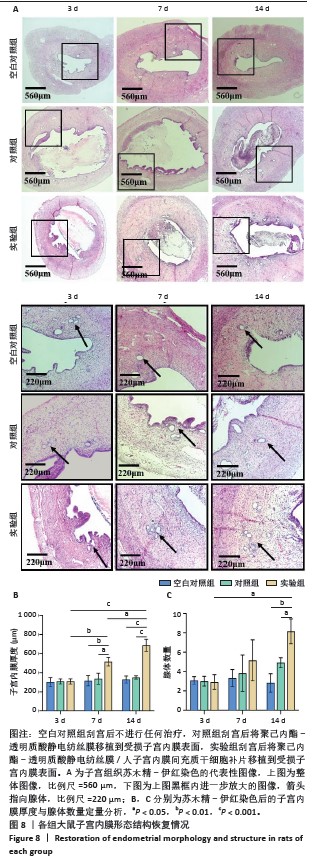
| [1] TINELLI A, ANDJIĆ M, MORCIANO A, et al. Uterine Aging and Reproduction: Dealing with a Puzzle Biologic Topic. Int J Mol Sci. 2023; 25(1):322. [2] FRANKFURTER D, KLIMAN H. Progress on the Endometrium. Obstet Gynecol Clin North Am. 2023;50(4):677-694. [3] HONG IS. Endometrial stem/progenitor cells: Properties, origins, and functions. Genes Dis. 2023;10(3):931-947. [4] HONG IS. Endometrial Stem Cells: Orchestrating Dynamic Regeneration of Endometrium and Their Implications in Diverse Endometrial Disorders. Int J Biol Sci. 2024;20(3):864-879. [5] GRIMBIZIS GF, DI SPIEZIO SARDO A, CAMPO R. Pregnancy-related intrauterine adhesion treatment: new insights. Fertil Steril. 2021; 116(4):1188. [6] VITALE SG, RIEMMA G, CARUGNO J, et al. Postsurgical barrier strategies to avoid the recurrence of intrauterine adhesion formation after hysteroscopic adhesiolysis: a network meta-analysis of randomized controlled trials. Am J Obstet Gynecol. 2022;226(4):487-498.e8. [7] ZHANG Y, LIN X, DAI Y, et al. Endometrial stem cells repair injured endometrium and induce angiogenesis via AKT and ERK pathways. Reproduction. 2016;152(5):389-402. [8] BAUSYTE R, VAIGAUSKAITE-MAZEIKIENE B, BORUTINSKAITE V, et al. Human endometrium-derived mesenchymal stem/stromal cells application in endometrial-factor induced infertility. Front Cell Dev Biol. 2023;11:1227487. [9] TERSOGLIO AE, TERSOGLIO S, SALATINO DR, et al. Regenerative therapy by endometrial mesenchymal stem cells in thin endometrium with repeated implantation failure. A novel strategy. J Bras Reprod Assist. 2020;24(2):118-127. [10] ZUO W, XIE B, LI C, et al. The Clinical Applications of Endometrial Mesenchymal Stem Cells. Biopreserv Biobank. 2018;16(2):158-164. [11] LV Q, WANG L, LUO X, et al. Adult stem cells in endometrial regeneration: Molecular insights and clinical applications. Mol Reprod Dev. 2021;88(6):379-394. [12] KHARBIKAR BN, MOHINDRA P, DESAI TA. Biomaterials to enhance stem cell transplantation. Cell Stem Cell. 2022;29(5):692-721. [13] CASTAÑO O, ELTOHAMY M, KIM HW. Electrospinning technology in tissue regeneration. Methods Mol Biol. 2012;811:127-140. [14] ZULKIFLI MZA, NORDIN D, SHAARI N, et al. Overview of Electrospinning for Tissue Engineering Applications. Polymers(Basel).2023;15(11):2418. [15] HONG J, YEO M, YANG GH, et al. Cell-electrospinning and its application for tissue engineering. Int J Mol Sci. 2019;20(24):6208. [16] BACKES EH, HARB SV, BEATRICE CAG, et al. Polycaprolactone usage in additive manufacturing strategies for tissue engineering applications: A review. J Biomed Mater Res B Appl Biomater. 2022;110(6):1479-1503. [17] GRAÇA MFP, MIGUEL SP, CABRAL CSD, et al. Hyaluronic acid-Based wound dressings: A review. Carbohydr Polym. 2020;241(April):116364. [18] YASIN A, REN Y, LI J, et al. Advances in Hyaluronic Acid for Biomedical Applications. Front Bioeng Biotechnol. 2022;10:910290. [19] AHMADIAN E, DIZAJ SM, EFTEKHARI A, et al. The Potential Applications of Hyaluronic Acid Hydrogels in Biomedicine. Drug Res. 2020;70(1): 6-11. [20] HUANG CY, CHANG WH, CHENG M, et al. Crosslinked hyaluronic acid gels for the prevention of intrauterine adhesions after a hysteroscopic myomectomy in women with submucosal myomas: A prospective, randomized, controlled trial. Life (Basel). 2020;10(5):67. [21] MA J, ZHAN H, LI W, et al. Recent trends in therapeutic strategies for repairing endometrial tissue in intrauterine adhesion. Biomater Res. 2021;25(1):40. [22] SMYTHE G. Role of Growth Factors in Modulation of the Microvasculature in Adult Skeletal Muscle. Adv Exp Med Biol. 2016;900: 161-183. [23] DEMIR R, SEVAL Y, HUPPERTZ B. Vasculogenesis and angiogenesis in the early human placenta. Acta Histochem. 2007;109(4):257-265. [24] THEIS V, THEISS C. VEGF-a stimulus for neuronal development and regeneration in the CNS and PNS. Curr Protein Pept Sci. 2018;19(6): 589-597. [25] BINDER NK, EVANS J, GARDNER DK, et al. Endometrial signals improve embryo outcome: Functional role of vascular endothelial growth factor isoforms on embryo development and implantation in mice. Hum Reprod. 2014;29(10):2278-2286. [26] FAN X, MURUGANANDAN S, SHALLIE PD, et al. Vegf maintains maternal vascular space homeostasis in the mouse placenta through modulation of trophoblast giant cell functions. Biomolecules. 2021;11(7):1062. [27] BOLATAI A, HE Y, WU N. Vascular endothelial growth factor and its receptors regulation in gestational diabetes mellitus and eclampsia. J Transl Med. 2022;20(1):400. [28] EL GEHANI K, AL-KIKHIA L, MANSURI N, et al. Angiogenesis in urinary bladder carcinoma as defined by microvessel density (MVD) after immunohistochemical staining for Factor VIII and CD31. Libyan J Med. 2011;6(1):1-6. [29] EMMERSON SJ, GARGETT CE. Endometrial mesenchymal stem cells as a cell based therapy for pelvic organ prolapse. World J Stem Cells. 2016;8(5):202-215. [30] VILELLA F, WANG W, MORENO I, et al. Understanding the human endometrium in the 21st century. Am J Obstet Gynecol. 2021;225(1): 1-2. [31] YOKOMIZO R, FUJIKI Y, KISHIGAMI H, et al. Endometrial regeneration with endometrial epithelium: homologous orchestration with endometrial stroma as a feeder. Stem Cell Res Ther. 2021;12(1):1-13. [32] LIU T, HE B, XU X. Repairing and Regenerating Injured Endometrium Methods. Reprod Sci. 2023;30(6):1724-1736. [33] SAAD-NAGUIB MH, KENFACK Y, SHERMAN LS, et al. Impaired receptivity of thin endometrium: therapeutic potential of mesenchymal stem cells. Front Endocrinol (Lausanne). 2024;14:1268990. [34] LI X, WANG Y, MA R, et al. Reconstruction of functional uterine tissues through recellularizing the decellularized rat uterine scaffolds by MSCs in vivo and in vitro. Biomed Mater. 2021;16(3):035023. [35] BRENNAN M, LAYROLLE P, MOONEY DJ. Biomaterials Functionalized with MSC Secreted Extracellular Vesicles and Soluble Factors for Tissue Regeneration. Adv Funct Mater. 2020;30(37):1909125. [36] COUSINS FL, FILBY CE, GARGETT CE. Endometrial Stem/Progenitor Cells-Their Role in Endometrial Repair and Regeneration. Front Reprod Health. 2022;3:811537. [37] DARZI S, WERKMEISTER JA, DEANE JA, et al. Identification and Characterization of Human Endometrial Mesenchymal Stem/Stromal Cells and Their Potential for Cellular Therapy. Stem Cells Transl Med. 2016;5(9):1127-1132. [38] FIGUEIRA PG, ABRÃO MS, KRIKUN G, et al. Stem cells in endometrium and their role in the pathogenesis of endometriosis. Ann N Y Acad Sci. 2011;1221(1):10-17. [39] BAGHAEI K, HASHEMI SM, TOKHANBIGLI S, et al. Isolation, differentiation, and characterization of mesenchymal stem cells from human bone marrow. Gastroenterol Hepatol Bed Bench. 2017; 10(3):208-213. [40] MACHADO CDE V, TELLES PD, NASCIMENTO IL. Immunological characteristics of mesenchymal stem cells. Rev Bras Hematol Hemoter. 2013;35(1):62-67. [41] YANG PJ, YUAN WX, LIU J, et al. Biological characterization of human amniotic epithelial cells in a serum-free system and their safety evaluation. Acta Pharmacol Sin. 2018;39(8):1305-1316. [42] CHEN L, GUO L, CHEN F, et al. Transplantation of menstrual blood-derived mesenchymal stem cells (MbMSCs) promotes the regeneration of mechanical injuried endometrium. Am J Transl Res. 2020;12(9): 4941-4954. [43] BACKLUND C, JALILI-FIROOZINEZHAD S, KIM B, et al. Biomaterials-Mediated Engineering of the Immune System. Annu Rev Immunol. 2023;41:153-179. [44] YANG ST, LIU CH, WANG PH. Combination of hyaluronic acid and mesenchymal stem cells for treatment of intrauterine adhesions. Taiwan J Obstet Gynecol. 2022;61(1):8-9. [45] MAURMANN N, FRANÇA FS, GIRÓN J, et al. Cell Electrospinning: a Review of Materials and Methodologies for Biofabrication. Adv Biol. 2023;7(10):e2300058. [46] AGARWAL G, AGIWAL S, SRIVASTAVA A. Hyaluronic acid containing scaffolds ameliorate stem cell function for tissue repair and regeneration. Int J Biol Macromol. 2020;165(Pt A):388-401. [47] LIU RM, SUN RG, ZHANG LT, et al. Hyaluronic acid enhances proliferation of human amniotic mesenchymal stem cells through activation of Wnt/β-catenin signaling pathway. Exp Cell Res. 2016; 345(2):218-229. [48] ATA B, LIÑÁN A, KALAFAT E, et al. Effect of the endometrial thickness on the live birth rate: insights from 959 single euploid frozen embryo transfers without a cutoff for thickness. Fertil Steril. 2023;120(1): 91-98. [49] TEMPEST N, HILL CJ, MACLEAN A, et al. Novel microarchitecture of human endometrial glands: Implications in endometrial regeneration and pathologies. Hum Reprod Update. 2022;28(2):153-171. [50] CHEN X, MAN GCW, LIU Y, et al. Physiological and pathological angiogenesis in endometrium at the time of embryo implantation. Am J Reprod Immunol. 2017;78(2). doi: 10.1111/aji.12693 [51] LI S, DING L. Endometrial perivascular progenitor cells and uterus regeneration. J Pers Med. 2021;11(6):477. [52] LERTKIATMONGKOL P, LIAO D, MEI H, et al. Endothelial functions of platelet/endothelial cell adhesion molecule-1 (CD31). Curr Opin Hematol. 2016;23(3):253-259. [53] FIGUEIREDO CC, PEREIRA NB, PEREIRA LX, et al. Double immunofluorescence labeling for CD31 and CD105 as a marker for polyether polyurethane-induced angiogenesis in mice. Histol Histopathol. 2019;34(3):257-264. [54] MASSRI N, LOIA R, SONES JL, et al. Vascular changes in the cycling and early pregnant uterus. JCI Insight. 2023;8(11):e163422. [55] ABU-GHAZALEH N, BRENNECKE S, MURTHI P, et al. Association of Vascular Endothelial Growth Factors (VEGFs) with Recurrent Miscarriage: A Systematic Review of the Literature. Int J Mol Sci. 2023; 24(11):9449. [56] BEHESHTIZADEH N, GHARIBSHAHIAN M, BAYATI M, et al. Vascular endothelial growth factor (VEGF) delivery approaches in regenerative medicine. Biomed Pharmacother. 2023;166:115301. [57] GUO X, YI H, LI TC, et al. Role of vascular endothelial growth factor (Vegf) in human embryo implantation: Clinical implications. Biomolecules. 2021;11(2):1-16. [58] CHEN Y, CHANG Y, YAO S. Role of Angiogenesis in Endometrial Repair of Patients with Severe Intrauterine Adhesion. Int J Clin Exp Pathol. 2013;6(7):1343-1350. |
| [1] | Sun Xianjuan, Wang Qiuhua, Zhang Jinyi, Yang Yangyang, Wang Wenshuang, Zhang Xiaoqing. Adhesion, proliferation, and vascular smooth muscle differentiation of bone marrow mesenchymal stem cells on different electrospinning membranes [J]. Chinese Journal of Tissue Engineering Research, 2025, 29(4): 661-669. |
| [2] | Wen Zhejia, Lyu Fang. Promotion of endometrial cell proliferation evaluated by platelet-rich plasma based on microfluidic chips [J]. Chinese Journal of Tissue Engineering Research, 2025, 29(10): 2091-2096. |
| [3] | Zhang Yicen, Wang Peixin, Liu Zhicheng. Ultrasound-guided injection of hyaluronic acid and corticosteroid for treating plantar fasciitis: evaluation of pain, fascia thickness and ankle-foot function [J]. Chinese Journal of Tissue Engineering Research, 2021, 25(11): 1670-1674. |
| Viewed | ||||||
|
Full text |
|
|||||
|
Abstract |
|
|||||
